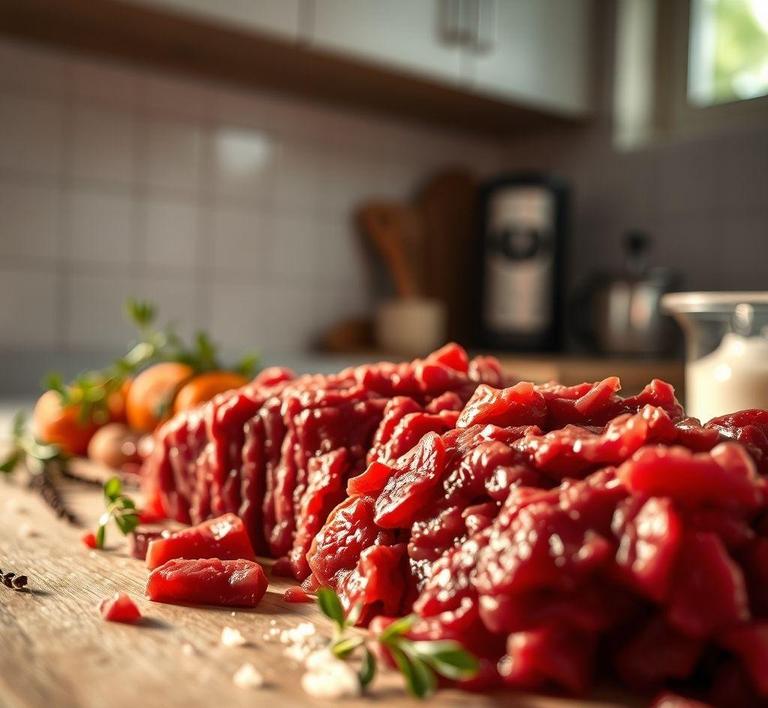When it comes to handling minced beef, knowing how to properly refreeze it can be a bit tricky, but it’s totally doable with the right steps. Whether you’ve thawed it for a recipe and now have leftovers, or you bought too much and need to freeze it again, understanding the process can help you avoid food waste and keep your meals safe. Refreezing minced beef involves following some essential guidelines, like ensuring it’s been handled properly during its initial thawing and keeping it at the correct temperatures throughout. In this guide, we’ll walk you through everything you need to know about refreezing minced beef without compromising its quality or safety!
Can You Refreeze Minced Beef?

When it comes to food safety and maintaining quality, one of the most commonly asked questions in the kitchen is whether you can refreeze minced beef. The short answer is: yes, but there are some important caveats to keep in mind.
Minced beef, or ground beef, is a highly perishable product due to its fine texture and increased surface area, which makes it more vulnerable to bacteria growth. If you’ve thawed minced beef properly and it’s been kept in a safe temperature zone, refreezing it is possible, but it comes with risks that may affect both its safety and quality. The key factors here are the initial thawing process, how long the beef has been kept at room temperature, and the condition of the meat before and after freezing.
The most important principle to follow is that beef should only be thawed in the fridge or through other controlled methods (like cold water thawing) to ensure its safety. Never refreeze minced beef that has been left at room temperature for longer than two hours, as bacteria can multiply rapidly in this time, increasing the risk of foodborne illness. Additionally, if the beef has already been refrozen once, you should avoid refreezing it a second time due to cumulative quality degradation and the potential for bacterial contamination.
How To Refreeze Minced Beef?
Refreezing minced beef properly is crucial to avoid compromising its safety and quality. Here’s a step-by-step guide on how to do it:
-
Check The Beef’s Current Condition
- Before even thinking about refreezing, assess the beef. If it was left out at room temperature for too long (more than two hours), or if it shows signs of spoilage (off smell, unusual color), discard it. Refreezing meat in questionable condition only makes things worse.
-
Thaw The Beef Correctly
- If the beef is frozen and you’re planning to cook it, always thaw it safely. The best way is to place the beef in the fridge overnight, as this keeps it at a safe temperature (below 40°F or 4°C). Alternatively, you can use the defrost setting on a microwave for quicker thawing, but this needs to be followed by cooking the beef immediately.
-
Cook Before Refreezing (Optional But Recommended)
- One of the safest ways to handle refreezing is to cook the minced beef after thawing. Cooking kills bacteria that may have started to grow during the thawing process, making it safer for refreezing. Once cooked, the beef can be portioned out and refrozen. Just be sure to let it cool completely before freezing to avoid condensation and ice crystals forming in the packaging.
-
Wrap And Seal The Beef Properly
- If you’re not cooking the beef before refreezing, the next best thing is to properly package it. Ensure it’s tightly wrapped or sealed in a freezer-safe bag or container, and try to remove as much air as possible. You can even vacuum-seal the minced beef to preserve its quality longer.
-
Label And Freeze Promptly
- Label your beef with the date of refreezing so you know how long it’s been in the freezer. Ideally, minced beef should be consumed within three to four months of being frozen, although it can last up to six months if stored properly.
-
Thawing After Refreezing
- When you’re ready to use the refrozen beef, always thaw it in the refrigerator rather than at room temperature. If you’re short on time, you can also cook the beef directly from frozen in certain recipes, but you should avoid repeatedly thawing and refreezing.
Quality Impact
Refreezing minced beef does impact its quality in several ways, and while the meat remains safe to eat if done correctly, the texture, flavor, and moisture content can suffer. Here’s how refreezing can affect your beef:
-
Texture Deterioration
- When minced beef is frozen, the water inside the meat forms ice crystals. These ice crystals puncture the muscle fibers and cell walls. The result is a loss of moisture when the meat is thawed. With each thaw and refreeze cycle, the beef’s texture becomes more mushy or crumbly, which is not ideal for dishes where texture matters, such as burgers or meatballs. The fat may also separate out, causing a greasy texture.
-
Loss Of Flavor
- Repeated freezing and thawing can cause flavor degradation. The initial freezing process can cause some loss of flavor, but each subsequent freeze will further diminish the richness and depth of the meat’s natural taste. If you plan to refreeze minced beef multiple times, the flavor may become less pronounced.
-
Moisture Loss
- One of the most significant issues with refreezing minced beef is moisture loss. Each time you freeze and thaw, water escapes from the meat, resulting in a drier texture when cooked. This can make the beef less juicy and flavorful, especially in recipes where the beef is the star, like tacos or pasta sauce.
-
Color Changes
- While not a major issue for safety, the color of minced beef can change with repeated freezing. Initially, beef will appear bright red, but after multiple freeze cycles, it may take on a duller, brownish tint. This is a sign of oxidation and doesn’t necessarily indicate that the beef is bad, but it can affect visual appeal.
While it is possible to refreeze minced beef under the right conditions, it’s important to approach it carefully to maintain food safety and quality. The key to successful refreezing lies in the initial thawing process, proper packaging, and, ideally, cooking the beef before refreezing. As a general rule, the fewer times you freeze and thaw your minced beef, the better the results will be, both in terms of safety and the quality of the meat.
If you’re planning on refreezing, try to limit it to once, and be mindful of the effects on texture and flavor. For optimal taste and texture, it’s best to use fresh minced beef within a short time frame. But if you do find yourself in a position where refreezing is necessary, following these steps will ensure that your minced beef remains as safe and enjoyable as possible.
Is It Safe To Refreeze Minced Beef?
Refreezing minced beef can be a tricky subject because of both safety and quality concerns. When minced beef is first frozen, it undergoes a process where the cold slows down or halts bacterial growth, preserving the meat for future use. However, once it’s thawed and exposed to warmer temperatures, the process of bacterial growth resumes, and the risk of contamination increases significantly.
The key factor in whether or not it’s safe to refreeze minced beef comes down to how the beef is handled before refreezing. If minced beef has been thawed properly-either in the refrigerator or using the cold water method-and has not spent too much time at room temperature, refreezing it can be done without too much concern. However, if it has been left at room temperature for over two hours, bacteria can multiply to dangerous levels, making refreezing unsafe.
Another important thing to consider is the duration for which the beef has been thawed. If it’s been thawed in the fridge for just a few days and hasn’t shown any signs of spoilage, it can usually be safely refrozen. But if it’s been left outside the refrigerator for too long, or the beef is showing any signs of spoilage (like an off smell or a change in color), it should not be refrozen.
The quality of minced beef also diminishes with each freeze-thaw cycle. Even if it is safe to refreeze the meat, you’ll notice a decline in texture, moisture, and flavor. The high surface area of minced beef means it’s particularly prone to freezer burn, which leads to an unpleasant dry, tough texture upon cooking.
Signs That Minced Beef Should Not Be Refrozen
There are several important indicators that minced beef should not be refrozen, and these signs often point to spoilage or unsafe conditions. Knowing these signs can help you avoid health risks.
- Off or Sour Smell: A rancid or sour odor is one of the clearest indicators that the minced beef has gone bad. Fresh ground beef should have a clean, neutral odor. If the meat smells sour or unusually pungent, it’s a sign that bacterial growth has occurred, and it is no longer safe to refreeze.
- Slimy Texture: Fresh minced beef should be firm, slightly moist, and free of any sliminess. If you touch the beef and it feels sticky, slippery, or slimy, it indicates bacterial activity, and the beef is no longer safe to refreeze or eat.
- Discoloration: When minced beef begins to turn a greyish-brown or even greenish color, it’s a clear sign that it has begun to spoil. Fresh minced beef is usually bright red or a pinkish hue, so any noticeable color change should raise immediate concerns.
- Extended Time Out of the Fridge: If minced beef has been left out at room temperature for more than two hours, the risk of bacterial contamination increases significantly. In fact, when meat is exposed to temperatures above 40°F (4°C) for extended periods, it enters the “danger zone”, where bacteria proliferate rapidly. At this point, refreezing is not recommended.
- Presence of Freezer Burn: If the minced beef shows signs of freezer burn, characterized by dry, discolored patches on the meat, it won’t harm you but will affect the quality. While freezer-burned beef can technically be refrozen, the quality will be compromised when cooked, leading to a dry, unappetizing meal. If you see extensive freezer burn, it’s better to discard the meat.
Common Refreezing Mistakes
While it might seem straightforward, refreezing minced beef often comes with a series of pitfalls. Here are some of the most common mistakes people make when trying to refreeze their beef, and why they should be avoided.
- Thawing at Room Temperature: One of the biggest mistakes people make is thawing beef at room temperature, which can encourage bacterial growth. Instead, minced beef should always be thawed in the refrigerator, where it can safely warm to a suitable temperature without reaching the danger zone for bacteria.
- Refreezing Beef More Than Once: Refreezing minced beef multiple times may seem like a good way to extend its shelf life, but this is a huge mistake. Every time you thaw and refreeze meat, it undergoes changes in texture and moisture content, which significantly impacts its flavor and quality. More importantly, each thawing cycle increases the risk of foodborne illness, as bacteria can multiply with each thaw.
- Using the Wrong Packaging: Minced beef should always be tightly wrapped in an airtight package before freezing. If you use loose packaging or bags that aren’t sealed well, the beef is exposed to air, leading to freezer burn and the loss of moisture. Additionally, improper packaging may allow cross-contamination with other foods in the freezer.
- Not Labeling the Meat: A common mistake is neglecting to label frozen minced beef with a date. If you don’t keep track of how long the beef has been frozen, it becomes harder to determine if it’s safe to refreeze. Always label the meat with the date of freezing to avoid keeping it past its recommended freezer storage time (typically 3-4 months for optimal quality).
- Freezing Too Much at Once: Freezing a large batch of minced beef all at once may sound efficient, but it can actually lead to uneven freezing. The beef will freeze slower, which can cause the growth of ice crystals inside the meat, negatively affecting its texture and overall safety. It’s better to divide minced beef into smaller portions before freezing.
Tips And Tricks
If you’ve decided to refreeze minced beef and want to do it safely and effectively, here are some essential tips and tricks to ensure you’re getting the most out of your meat:
- Portion Control: Before freezing minced beef, divide it into smaller portions that you’ll use in one go. This way, you can thaw only what you need and avoid having to refreeze leftovers. Small portions freeze and thaw more evenly, which helps preserve quality.
- Proper Thawing: The safest way to thaw minced beef is in the refrigerator, where it can defrost at a controlled temperature. If you need to thaw beef more quickly, you can place the meat in a sealed bag and submerge it in cold water, changing the water every 30 minutes. Always cook the beef immediately after thawing with the cold water method.
- Avoid Refreezing Cooked Beef: It’s generally safer to refreeze cooked minced beef than raw. Cooking the meat will kill bacteria that may have grown, but you still need to ensure that it was cooked thoroughly and not left at room temperature for too long. When refreezing cooked beef, make sure to cool it down quickly to avoid any bacterial growth.
- Vacuum Sealing: If you’re serious about preserving the quality of minced beef, consider using a vacuum sealer. This method removes all air from the packaging, preventing freezer burn and helping the beef retain its moisture and flavor for a longer period. Vacuum-sealed beef can last up to a year in the freezer, retaining much of its original texture.
- Use within the Right Timeframe: Even if refreezing is safe, remember that the quality of minced beef will degrade the longer it stays in the freezer. Aim to consume refrozen minced beef within a few months, ideally no more than 3-4 months, for the best flavor and texture.
Conclusion
Refreezing minced beef is a nuanced decision that depends heavily on proper handling and awareness of the meat’s condition. While it can be done safely if the beef was thawed correctly and hasn’t been exposed to harmful bacteria, the quality will inevitably decrease with each freeze-thaw cycle. To ensure that you’re getting the most out of your minced beef, it’s important to follow safe thawing practices, avoid refreezing too often, and handle the meat with care throughout the entire process.
By recognizing the signs that minced beef should not be refrozen-such as off smells, sliminess, or discoloration-and avoiding common mistakes like thawing at room temperature, you can reduce your risk of foodborne illness and improve the quality of your dishes. With the right preparation, refreezing minced beef can be an efficient way to preserve meat, but it’s always best to freeze in smaller portions, package it properly, and consume it within a reasonable timeframe to avoid unnecessary waste.


